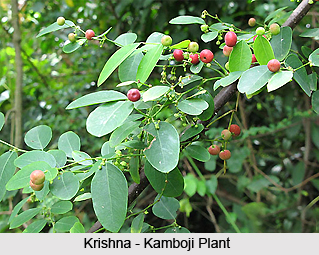 Krishna-Kamboji or Buinowla is a large shrub with a height of 4.5 m and smooth or lenticellate branches. The botanical name of the plant is Kirganelia reticulata (Poir.) Baill. Krishna-Kamboji is the Sanskrit name of the plant and it is known as Buinowla, Makhi, Panjoli or Panjuli in Hindi. The plant is called in different names in different Indian languages. The Bengali name of the plant is Panjuli and its Gujarati names are Datwan and Kam-Boi. The Kannada speaking people know the plant as Anamsule, Chippulinellu, Huli, Karesuli, etc. and in Konkani; it is called as Kaili. The Marathi names of the plant include Pavan and Pavana and its Oriya names are Bonoti-Hudi, Jandaki, Jojangi or Phajoli. Panjuli is the Punjabi name of the plant, while in Tamil; it is known as Abiranji, Karunelli, Karuppupilanji or Nirppu-Lanji. The Telugu speaking people call Krishna-Kamboji as Nallapuli, Nal-Lapuruguda, Nellapurududu or Pandicarranlue.
Krishna-Kamboji or Buinowla is a large shrub with a height of 4.5 m and smooth or lenticellate branches. The botanical name of the plant is Kirganelia reticulata (Poir.) Baill. Krishna-Kamboji is the Sanskrit name of the plant and it is known as Buinowla, Makhi, Panjoli or Panjuli in Hindi. The plant is called in different names in different Indian languages. The Bengali name of the plant is Panjuli and its Gujarati names are Datwan and Kam-Boi. The Kannada speaking people know the plant as Anamsule, Chippulinellu, Huli, Karesuli, etc. and in Konkani; it is called as Kaili. The Marathi names of the plant include Pavan and Pavana and its Oriya names are Bonoti-Hudi, Jandaki, Jojangi or Phajoli. Panjuli is the Punjabi name of the plant, while in Tamil; it is known as Abiranji, Karunelli, Karuppupilanji or Nirppu-Lanji. The Telugu speaking people call Krishna-Kamboji as Nallapuli, Nal-Lapuruguda, Nellapurududu or Pandicarranlue.
Krishna-Kamboji is commonly found in the low-lying moist habitats in thickets and hedges along rivers, irrigation channels and wastelands throughout most of tropical India. The plant is grown at an altitude of 1800 m in the state of Meghalaya. The plant usually flowers and fruits throughout most of the year. However, its flowering season depends on the locale and it usually remains leafless between January and February.
Krishna-Kamboji is a straggling or climbing shrub and its leaves are alternate, elliptic-oblong or obovate. The leaves reach a length of up to 3.2 cm and a width of 1.8 cm. They are acute or rounded at both ends and their lower surface is of pale green colour. The petioles have a length of up to 0.3 cm and the minute stipules are ovate and acute. The plant`s flowers have a reddish colour and they are unisexual and axillary. The male flowers remain 2-6 together in fascicles and the female flowers are solitary. The fruit (capsule) of Krishna-Kamboji is fleshy and sub-globose and has a diameter of 0.5 cm. The fruit becomes purplish-black in colour when ripe and it contains 8-16 irregularly trigonous seeds.
There are many medicinal properties and uses of Krishna-Kamboji or Buinowla. The plant is quite commonly used in various traditional medicines. The leaves of the plant are considered diuretic and cooling and are often used externally in the form of a paste, by the Kondhs of southwestern Orissa. They used the leaves to relieve headache. The Mundas of southern Bihar also use the leaves as a powder to promote healing of ulcers and boils. A juice made from the leaves of the plant is often used to relieve diarrhoea in infants. The juice is also used to treat bleeding gums, after being made into a pill with camphor and cubebs. The tribal inhabitants of Andhra Pradesh apply another juice made from the stems of Krishna-Kamboji or Buinowla to the teeth to relieve severe toothache and infected gums. The twigs are also used as toothbrushes in Bhavnagar district of Gujarat.
The fruit of Krishna-Kamboji or Buinowla works as an astringent to the bowels and is also useful as a purgative, for treating diseases of the blood. The fruit can be used for treating syphilitic sores as well. Sometimes, the children are given a decoction of the root to treat asthma, coughs and catarrh. The plant`s bark has a faintly sweet taste and is considered alterative, attenuant, astringent and diuretic. The bark is sometimes used for treating rheumatism, dysentery and venereal diseases. Apart from these, the tribal inhabitants of western Maharashtra take an infusion of the bark internally to relieve swellings as well.



















